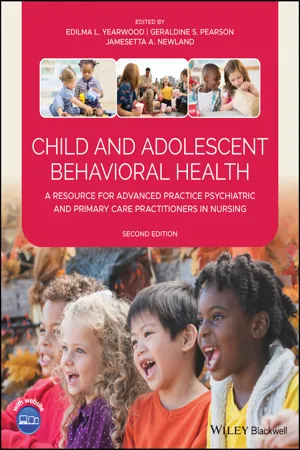
Child and Adolescent Behavioral Health
A Resource for Advanced Practice Psychiatric and Primary Care Practitioners in Nursing
- English
- ePUB (mobile friendly)
- Available on iOS & Android
Child and Adolescent Behavioral Health
A Resource for Advanced Practice Psychiatric and Primary Care Practitioners in Nursing
About this book
Research has shown that a range of adult psychiatric disorders and mental health problems originate at an early age, yet the psychiatric symptoms of an increasing number of children and adolescents are going unrecognized and untreated—there are simply not enough child psychiatric providers to meet this steadily rising demand. It is vital that advanced practice registered nurses (APRNs) and primary care practitioners take active roles in assessing behavioral health presentations and work collaboratively with families and other healthcare professionals to ensure that all children and adolescents receive appropriate treatment.
Child and Adolescent Behavioral Health helps APRNs address the mental health needs of this vulnerable population, providing practical guidance on assessment guidelines, intervention and treatment strategies, indications for consultation, collaboration, referral, and more. Now in its second edition, this comprehensive and timely resource has been fully updated to include DSM-5 criteria and the latest guidance on assessing, diagnosing, and treating the most common behavioral health issuesfacing young people. New and expanded chapters cover topics including eating disorders, bullying and victimization, LGBTQ identity issues, and conducting research with high-risk children and adolescents. Edited and written by a team of accomplished child psychiatric and primary care practitioners, this authoritative volume:
- Provides state-of-the-art knowledge about specific psychiatric and behavioral health issues in multiple care settings
- Reviews the clinical manifestation and etiology of behavioral disorders, risk and management issues, and implications for practice, research, and education
- Offers approaches for interviewing children and adolescents, and strategies for integrating physical and psychiatric screening
- Discusses special topics such as legal and ethical issues, cultural influences, the needs of immigrant children, and child and adolescent mental health policy
- Features a new companion website containing clinical case studies to apply concepts from the chapters
Designed to specifically address the issues faced by APRNs, Child and Adolescent Behavioral Health is essential reading for nurse practitioners and clinical nurse specialists, particularly those working in family, pediatric, community health, psychiatric, and mental health settings. *Second Place in the Child Health Category, 2021 American Journal of Nursing Book of the Year Awards*
Frequently asked questions
- Essential is ideal for learners and professionals who enjoy exploring a wide range of subjects. Access the Essential Library with 800,000+ trusted titles and best-sellers across business, personal growth, and the humanities. Includes unlimited reading time and Standard Read Aloud voice.
- Complete: Perfect for advanced learners and researchers needing full, unrestricted access. Unlock 1.4M+ books across hundreds of subjects, including academic and specialized titles. The Complete Plan also includes advanced features like Premium Read Aloud and Research Assistant.
Please note we cannot support devices running on iOS 13 and Android 7 or earlier. Learn more about using the app.
Information
1
Child, Adolescent, and Family Development
Objectives
- Understand child and adolescent development within biopsychosocial and environmental contexts.
- Identify characteristics over the developmental continuum that represent age‐appropriate social and emotional behaviors of typically developing children and youth.
- Determine at‐risk behaviors in children and youth across the developmental span requiring referral for additional evaluation.
- Describe behaviors manifested by children and youth with high secure self‐esteem, high insecure self‐esteem, and low self‐esteem.
- Compare and contrast models of cognitive development and their application to practice.
- Demonstrate an understanding of common characteristics of language (phonology, morphology, syntax, semantics, and pragmatics) and language development.
- Identify normal patterns of family development.
- Identify social determinants of health that impact normal child development.
Introduction
Prenatal Development
Brain Development
Table of contents
- Cover
- Table of Contents
- Title Page
- Copyright Page
- Dedication Page
- About the Editors
- List of Contributors
- Forward
- Forward
- Preface to Second Edition
- Acknowledgment
- About the Companion Website
- 1 Child, Adolescent, and Family Development
- 2 Temperament and Self‐Regulation
- 3 Neurobiology and Neurophysiology of Behavioral/Psychiatric Disorders
- 4 Integration of Physical and Psychiatric Assessment
- 5 Child Sexual Development
- 6 Adolescent Sexual Behaviors
- 7 Assessing and Managing the Needs of LGBTQ Youth
- 8 Adverse Childhood Experiences
- 9 Psychopharmacology
- 10 Attention Deficit Hyperactivity Disorder
- 11 Anxiety Disorders
- 12 Mood Dysregulation Disorders
- 13 Deliberate Self‐harm
- 14 Perceptual Alterations Disorders
- 15 Feeding and Eating Disorders in Children and Adolescents
- 16 Autism Spectrum Disorder
- 17 Learning and Intellectual Disabilities
- 18 Nonpharmacological Treatment Modalities
- 19 Individual and Family Therapies
- 20 Cognitive Behavioral Interventions in Child and Adolescent Mental Health Treatment
- 21 Disorders Specific to Infants and Young Children
- 22 Juvenile Justice Populations
- 23 Substance Use
- 24 Child and Adolescent Victims of Trauma
- 25 Children in Out‐of‐Home Placement
- 26 Chronic and Palliative Care Pediatric Populations
- 27 Collaborative Treatment with Primary Care
- 28 Legal and Ethical Issues
- 29 Evidence‐based Nursing Practice
- 30 Cultural Influences on Child and Adolescent Mental Health
- 31 Conducting Behavioral Health Research with Children and Using Research Methods
- 32 Advanced Practice Registered Nurses Interfacing with the School System
- 33 Child and Adolescent Mental Health Policy
- Index
- End User License Agreement